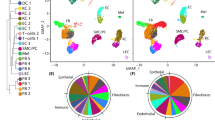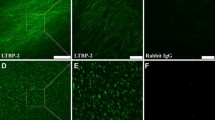Abstract
The present study was designed to investigate the expression of type I, III and VI collagens by a fibroblast cell line initiated from a hypertrophic scar. The same tissue has previously been demonstrated to display markedly elevated expression of type I and III collagen mRNAs in vivo. Unexpectedly, slot-blot and Northern hybridizations revealed a barely detectable steady-state level of proα1(III) collagen chain mRNA in cultured hypertrophic scar fibroblasts. The levels of proα1(I) and α2(VI) collagen chain mRNAs were essentially the same in fibroblasts cultured from hypertrophic scar and in fibroblasts cultured from normal skin. However, Northern blot analyses indicated that the ratio of 5.8 kb to 4.8 kb species of proα1(I) collagen mRNA was slightly reduced in fibroblasts originating from the hypertrophic scar compared to that in normal fibroblasts. When normal fibroblasts were incubated in conditioned medium from hypertrophic scar cultures, the expression of proα1(III) collagen chain mRNA decreased to a markedly lower level. Our studies suggest that collagen synthesis by fibroblasts in hypertrophic scars is stimulated by humoral factors which are active only in vivo. Furthermore, the results suggest that fibroblasts cultured from hypertrophic scar display a selective downregulation of different collagen genes and that this downregulation is exerted through an autocrine mechanism.
Similar content being viewed by others
References
Abergel RP, Pizzurro D, Meeker CA, Lask G, Matsuoka LY, Minor RR, Chu M-L, Uitto J (1985) Biochemical composition of the connective tissue in keloids and analysis of collagen metabolism in keloid fibroblast cultures. J Invest Dermatol 84: 384–390
Ala-Kokko L, Rintala A, Savolainen ER (1987) Collagen gene expression in keloids: analysis of collagen metabolism and type I, III, IV, and V procollagen mRNA in keloid tissue and keloid fibroblast cultures. J Invest Dermatol 89: 238–244
Chomczynski P, Sacchi N (1987) Single-step method of RNA isolation by acid guanidinium thiocyanate-phenol-chloroform extraction. Anal Biochem 162: 156–159
Chu M-L, Myers JC, Bernard MP, Ding J-F, Ramirez F (1982) Cloning and characterization of five overlapping cDNAs specific for the human proα1(I) collagen chain. Nucleic Acids Res 10: 5925–5934
Chu M-L, Weil D, de Wet W, Bernard M, Sippola M, Ramirez R (1985) Isolation of cDNA and genomic clones encoding human proα1(III) collagen: partial characterization of the 3′-end region of the gene. J Biol Chem 260: 4357–4363
Chu M-L, Mann K, Deutzmann R, Pribula-Conway D, Hau-Chen C-C, Bernard MP, Timpl R (1987) Charaterization of three constituent chains of collagen type VI by peptide sequences and cDNA clones. Eur J Biochem 168: 309–317
Fort P, Marty L, Piechaczyk M, El Sabrouty S, Dani C, Jeanteur P, Blanchard JM (1985) Various rat adult tissues express only one major mRNA species from the glyceraldehyde-3-phosphate-dehydrogenase multigenic family. Nucleic Acids Res 13: 1431–1442
Ihlberg L, Haukipuro K, Risteli L, Oikarinen A, Kairaluoma M, Risteli J (1993) Collagen synthesis in intact skin is suppressed during wound healing. Ann Surg 217: 397–403
Jaakkola S, Peltonen J, Riccardi V, Chu M-L, Uitto J (1989) Type 1 neurofibromatosis: selective expression of extracellular matrix by Schwann cells, perineurial cells, and fibroblasts in mixed cultures. J Clin Invest 84: 253–261
Kallioinen M, Sandberg M, Kallioinen M, Oikarinen A (1992) Collagen synthesis in granuloma annulare. J Invest Dermatol 98: 463–468
Karsenty G, de Crombrugghe B (1990) Two different negative and positive regulatory factors interact with a short promoter segment of the α1(I) collagen gene. J Biol Chem 265: 9934–9942
Karsenty G, Ravazzolo R, de Crombrugghe B (1991) Purification and functional characterization of a DNA-binding protein that interacts with a negative element in the mouse α1(I) collagen promoter. J Biol Chem 266: 24842–24848
Kischer CW, Pindur J, Krasovitch P, Kischer E (1990) Characteristics of granulation tissue which promote hypertrophic scarring. Scanning Electron Microsc 4: 877–888
LeRoy EC (1974) Increased collagen synthesis by scleroderma skin fibroblasts in vitro. J Clin Invest 54: 880–889
Määttä A, Bornstein P, Penttinen RPK (1991) Highly conserved sequences in the 3′-untranslated region of the COL1A1 gene bind cell-specific nuclear proteins. FEBS Lett 279: 9–13
Oikarinen A, Kinnunen T, Kallioinen M (1989) Biochemical and immunohistochemical composition of collagen in granuloma annulare and skin sarcoidosis. Acta Derm Venerol (Stockh) 69: 277–283
Oikarinen A, Mäkelä J, Vuorio T, Vuorio E (1991) Comparison on collagen gene expression in the developing chick embryo tendon and heart. Tissue and development time-dependent action of dexamethasone. Biochim Biophys Acta 1089: 40–46
Olsen D, Peltonen J, Jaakkola S, Chu M-L, Uitto J (1989) Collagen gene expression by cultured human skin fibroblasts: Abundant steady-state levels of type VI procollagen messenger RNAs. J Clin Invest 83: 791–795
Peltonen J, Jaakkola S, Gay K, Olsen DR, Chu M-L, Uitto J (1989) Expression of extracellular matrix genes by cultured human cells: localization of messenger RNAs and antigenic epitopes. Anal Biochem 178: 184–193
Peltonen J, Hsiao L-L, Jaakkola S, Sollberg S, Aumailley M, Timpl R, Chu M-L, Uitto J (1991) Activation of collagen gene expression in keloids: co-localization of type I and VI collagen and transforming growth factor-β1 mRNA. J Invest Dermatol 97: 240–248
Peltonen L, Palotie A, Myllylä R, Krieg T, Oikarinen A (1985) Collagen biosynthesis and synthesis of procollagen in cultured fibroblasts. J Invest Dermatol 84: 14–18
Penttinen RP, Kobayashi S, Bornstein P (1988) Transforming growth factor-β increases mRNA for matrix proteins both in the presence and in the absence of changes in mRNA stability. Proc Natl Acad Sci USA 85: 1105–1108
Rockwell WB, Cohen IK, Ehrlich HP (1989) Keloids and hypertrophic scars: a comprehensive review. Plast Reconstr Surg 84: 827–837
Rudolph R (1987) Wide spread scars, hypertrophic scars and keloids. Clin Plast Surgery 14: 253–260
Scharffetter K, Kulozik M, Stolz W, Lankat-Buttgereit B, Hatamochi A, Söhnchen R, Krieg T (1989) Localization of collagen α1(I) gene expression during wound healing by in situ hybridization. J Invest Dermatol 93: 405–412
Simkevich CP, Thompson JP, Poppleton H, Raghow R (1992) The transcriptional tissue specificity of the human proα1(I) collagen gene is determinated by a negative cis-regulatory element in the promoter. Biochem J 286: 179–185
Uitto J, Perejda AJ, Abergel RP, Chu M-L, Ramirez F (1985) Altered steady-state ratio of type I/III procollagen mRNAs correlates with selectively increased type I procollagen biosynthesis in cultured keloid fibroblasts. Proc Natl Acad Sci USA 82: 5935–5939
Vuorio T, Mäkelä JK; Kähäri VM, Vuorio E (1987) Coordinated regulation of type I and type III collagen production and mRNA levels of pro alpha1(I) and pro alpha2(I) collagen in cultured morphea fibroblasts. Arch Dermatol Res 279: 154–160
Zhang L-Q, Laato M, Muona P, Kalimo H, Peltonen J (1994) Normal and hypertrophic scars: qantification and localization of messenger RNAs for type I, III and VI collagen. Br J Dermatol 130: 453–459
Author information
Authors and Affiliations
Rights and permissions
About this article
Cite this article
Zhang, L.Q., Laato, M., Muona, P. et al. A fibroblast cell line cultured from a hypertrophic scar displays selective downregulation of collagen gene expression: barely detectable messenger RNA levels of the proα1(III) chain of type III collagen. Arch Dermatol Res 287, 534–538 (1995). https://doi.org/10.1007/BF00374072
Received:
Issue Date:
DOI: https://doi.org/10.1007/BF00374072




